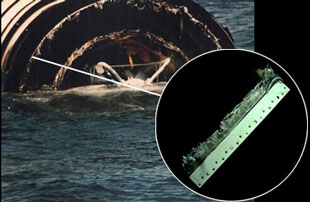
The Solid Rocket Boosters (SRB) are the largest solid- propellant motors ever flown and the first designed for reuse. Each is 149.16 feet long and 12.17 feet in diameter. They provide the main thrust to lift the Space Shuttle off the pad and up to an altitude of about 150,000 feet.
The SRBs are composed of a forward skirt assembly, four solid rocket booster segments, an aft skirt assembly, and an exit cone. The aft skirt assembly encases the motor, including propellant, igniter and nozzle.
Within the aft skirt, a glass fiber (with a silicone rubber coating) curtain is used to protect the SRB's guidance system and to prevent any of the local fauna from nesting or taking up residence inside the hardware and possibly affecting its function. In addition, above this curtain are two hydraulic actuators which are powered by hydrazine. The curtain acts as a thermal barrier to prevent auto-ignition of the hydrazine fuel and damage to the equipment.
These curtains are mostly destroyed after separation from the Space Shuttle and during the impact with the ocean. Fragments like this one are commonly discarded after each flight.
This bracket, which held the curtain in place inside the aft skirt, is affectionately known by engineers as the "whale bone" because it reminded someone of the rib of a whale.
Due to the lack of markings indicating what mission each SRB has flown, it is difficult, if not impossible, to identify which flights this bracket flew with; however, based on when it was recovered, it is believed that the SRB flew sometime between STS-32 and STS-46 (1990-1992).

© 2020 collectSPACE.com All rights reserved.
Questions? E-mail [email protected]

|